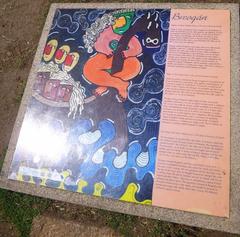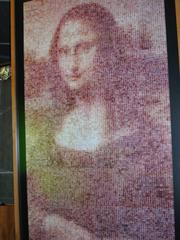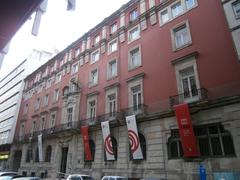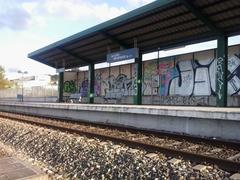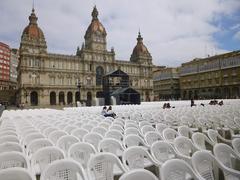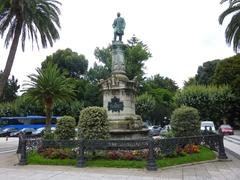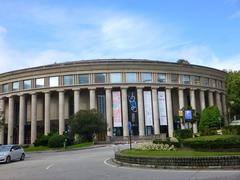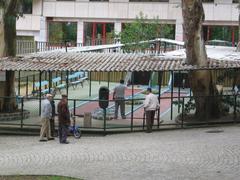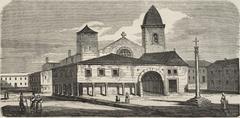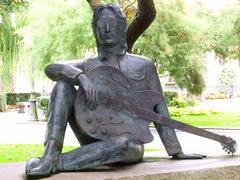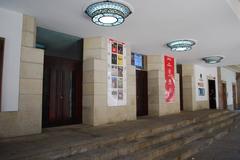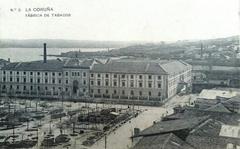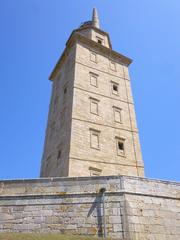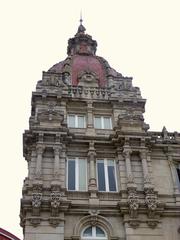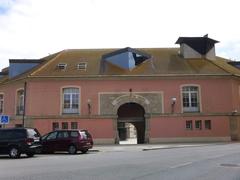Casa Do Sol: Visiting Hours, Tickets, and Historical Significance in A Coruña, Spain
Date: 04/07/2025
Introduction
Casa Do Sol, nestled in the heart of A Coruña, Spain, stands as a testament to the city’s rich history, architectural innovation, and vibrant cultural life. Originally built in the early 20th century as an anti-tuberculosis dispensary, this modest yet architecturally significant building reflects the city’s proactive approach to public health and communal resilience. Over time, Casa Do Sol has evolved to become a dynamic cultural and social hub, housing the Festival Commission and serving as the headquarters for the local Tourist Office. Conveniently located near Orzán Beach and the lively Paseo Marítimo, it offers visitors an exceptional blend of historical insight and contemporary urban energy (gl.wikipedia.org; coruneando.com; elespanol.com).
This guide provides a comprehensive overview of Casa Do Sol’s origins, architectural features, cultural importance, and practical visitor information, including up-to-date visiting hours, ticketing, accessibility, and nearby attractions. Whether you are an architecture enthusiast, history buff, or cultural traveler, Casa Do Sol offers an immersive experience into the layered stories and vibrant life of A Coruña.
Table of Contents
- Origins and Early Purpose
- Architectural Features and Innovations
- Evolution of Use and Social Significance
- Urban Context and Cultural Identity
- Visiting Casa Do Sol: Practical Information
- The Galerías of A Coruña: Architectural Heritage
- Integrating Casa Do Sol into Your A Coruña Itinerary
- Frequently Asked Questions (FAQ)
- Conclusion
- References
Origins and Early Purpose
Casa Do Sol was conceived in the early 1900s, amid a wave of public health reforms designed to combat the rampant spread of tuberculosis in Galicia and across Europe. Designed by municipal architect Pedro Mariño—also known for the iconic Palacio Municipal de María Pita—the building was constructed between 1905 and 1906 (gl.wikipedia.org; coruneando.com).
Community support was instrumental in its realization; local citizens provided donations, reflecting a collective spirit in addressing public health crises. While initially envisioned for a different site, the dispensary ultimately found its home at the corner of Rúa Sol and Avenida de Pedro Barrié de la Maza, directly facing Orzán Beach.
Architectural Features and Innovations
Casa Do Sol exemplifies early 20th-century civic architecture with modernist influences. The single-story, 12x12 meter square plan features:
- Symmetrical facades with decorative cornices and a central skylight (lucernario) that once illuminated the waiting area (gl.wikipedia.org).
- Curved building corners, a soft deviation from the era’s typical angularity (elespanol.com).
- Rendered brick construction with moldings, reliefs, columns, and capitals mimicking carpentry.
- Concealed window lintels, a forward-thinking structural feature preceding broader adoption in modernist design.
Mariño’s design allowed the building to be easily adapted for new purposes—an insight that would prove prescient as Casa Do Sol transitioned from a medical facility to a civic and cultural center (elespanol.com).
Evolution of Use and Social Significance
As tuberculosis ceased to pose the same threat, Casa Do Sol’s function shifted. Today, it is owned by the Concello da Coruña and serves as a base for the Festival Commission and the city’s Tourist Office (gl.wikipedia.org; coruneando.com). Its role now includes:
- Hosting cultural events and exhibitions.
- Providing tourist information and resources.
- Acting as a symbol of A Coruña’s adaptability and civic pride.
The building stands as a living monument to the power of community-driven public health efforts and the ongoing importance of civic engagement.
Urban Context and Cultural Identity
Situated in the historically working-class Pescadería neighborhood, Casa Do Sol anchors itself between the city’s natural beauty and urban vibrancy. Its prominent position near Orzán Beach and the Paseo Marítimo makes it a notable landmark—often described as an “icon in the profile of the Orzán bay” (elespanol.com).
The building’s facade features contemporary artistic interventions, such as sculptures by Xerión, reflecting its continued dialogue with the city’s evolving culture (coruneando.com).
Visiting Casa Do Sol: Practical Information
Visiting Hours
- Typical hours: Tuesday to Sunday, 10:00 AM – 6:00 PM (last entry at 5:30 PM).
- Closed Mondays and public holidays.
- Hours may vary seasonally and during special events; always check the official website before visiting.
Tickets and Entry
- General admission is free of charge.
- Special exhibitions or guided tours may require advance booking and a nominal fee. Details available at the tourist office or online.
Accessibility
- The building includes ramps and facilities for visitors with reduced mobility.
- Assistance is available from staff at the Tourist Office.
Guided Tours and Special Events
- Guided tours are periodically organized by the City Council, focusing on architectural and historical themes.
- Special events and exhibitions occur throughout the year; check the events calendar for current offerings.
Nearby Attractions and Travel Tips
- Attractions: Orzán Beach, María Pita Square, Tower of Hercules, Aquarium Finisterrae.
- Transport: Accessible by city bus, with public garages (e.g., PALEXCO) nearby (passaportenobolso.com).
- Best visiting seasons: Spring and early autumn offer mild weather and fewer crowds (adventurebackpack.com).
- Language: Signage is primarily in Galician and Spanish; English support is limited.
The Galerías of A Coruña: Architectural Heritage
A defining feature of A Coruña’s urban identity is the galerías—glass-enclosed balconies that line many city facades, earning A Coruña the nickname “glass city” (Galicia Guide). These structures:
- Originate from fishermen’s houses, later adapted for multi-story buildings.
- Extend living spaces, provide natural light, and offer shelter from the Atlantic climate.
- Feature intricate woodwork or metal details and grid-like glass panes.
- Are most prominent on Avenida da Marina but found throughout the city.
Preservation efforts ensure that galerías remain central to A Coruña’s architectural charm, blending tradition with modern needs (Galicia Guide; Rough Guides).
Integrating Casa Do Sol into Your A Coruña Itinerary
Morning: Begin at Plaza de María Pita, walk to Casa Do Sol, and enjoy its architecture and exhibitions (thisremotecorner.com).
Midday: Visit nearby museums such as the Museo Arqueológico e Histórico or Museo de Belas Artes (passaportenobolso.com).
Afternoon: Stroll the Paseo Marítimo, see the Tower of Hercules, or relax at Riazor or Orzán beaches (theorangebackpack.nl).
Evening: Enjoy dinner and nightlife in the Old Town or marina area.
For multi-day stays, consider day trips to Santiago de Compostela (passaportenobolso.com), natural parks, or local festivals (coruna.gal/cultura).
Frequently Asked Questions (FAQ)
Q: What are Casa Do Sol’s visiting hours?
A: Tuesday to Sunday, 10:00 AM – 6:00 PM (last entry 5:30 PM); closed Mondays and public holidays. Confirm on the official website.
Q: Is admission free?
A: Yes, general admission is free. Special events or tours may require tickets.
Q: Is the building accessible for visitors with disabilities?
A: Accessibility features are present, but inquire in advance for specific needs.
Q: Are guided tours available in English?
A: Most tours are in Spanish or Galician; English tours may be offered during peak seasons.
Q: Can I take photos inside?
A: Photography is generally allowed in public spaces, but restrictions may apply during exhibitions.
Conclusion
Casa Do Sol is more than a historic building; it is a living symbol of A Coruña’s resilience, creativity, and sense of community. Its evolution from a public health dispensary to a cultural landmark mirrors the city’s vibrant spirit and capacity for reinvention. Visitors can enjoy free entry, guided tours, and proximity to some of A Coruña’s most emblematic sites, including the city’s iconic galerías. To make the most of your visit, check official websites for current hours and events, and consider incorporating Casa Do Sol into a broader exploration of A Coruña’s historical and architectural treasures.
For the latest updates, download the Audiala app, follow local social media, and consult official city resources.
References
- Casa Do Sol, 2023, Wikipedia
- Casa Do Sol Edificio, 2021, Coruneando
- Casa Do Sol History, 2021, El Español
- Galicia Guide, 2024, Glass City A Coruña
- Rough Guides, 2024, A Coruña Travel Guide
- Brogan Abroad, 2023, Things to Do in A Coruña
- Concello da Coruña Official Culture Site, 2024
- Passaporte no Bolso, 2023, A Coruña Itinerary
- Adventure Backpack, 2023, A Coruña Itinerary
- This Remote Corner, 2024, La Coruña Things to Do


